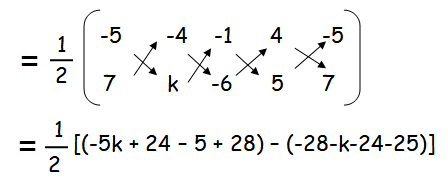QUADRILATERAL EXAMPLE PROBLEMS WITH FOUR VERTICES
Question 1 :
If vertices of quadrilateral are at A(-5, 7) , B(-4, k) , C(-1, -6) and D(4, 5) and its area is 72 sq.units. Find the value of k.
Solution :
Area of quadrilateral = 72 sq.units


(-5k + 52 - 5) - (-77 - k) = 2(72)
-5k + 47 + 77 + k = 144
-4k + 124 = 144
-4k = 144 - 124
-4k = 20
k = -5
Question 2 :
Without using distance formula, show that points (-2, -1) , (4, 0) , (3, 3) and (-3, 2) are the vertices of a parallelogram.
Solution :
Let the given vertices be A (-2, -1) B (4, 0) C (3, 3) and D (-3, 2).
If the given vertices form a parallelogram,
Midpoint of AC = Midpoint of BD
Midpoint = (x1 + x2)/2, (y1 + y2)/2
Midpoint of AC = (-2 + 3)/2, (-1 + 3)/2
= (1/2, 2/2)
= (1/2, 1)-------(1)
Midpoint of BD = (4 + (-3))/2, (0 + 2)/2
= (1/2, 2/2)
= (1/2, 1)-------(2)
Hence the given points form a parallelogram.
Question 3 :
Find the equations of the lines, whose sum and product of intercepts are 1 and –6 respectively.
Solution :
Let "a" and "b" be the x and y -intercepts.
Sum of intercept = 1
a + b = 1
Product of intercept = -6
ab = -6
b = -6/a
a + (- 6/a) = 1
a2 - 6 = a
a2 - a - 6 = 0
(a - 3) (a + 2) = 0
a = 3 and a = -2
|
If a = 3 b = -6/3 b = -2 a = 3 and b = -2 (x/3) + (y/(-2)) = 1 (2x + 3y)/(-6) = 1 2x + 3y = -6 |
If a = -2 b = -6/(-2) b = 3 a = -2 and b = 3 (x/(-2)) + (y/3) = 1 (-3x + 2y)/6 = 1 -3x + 2y = 6 3x - 2y = -6 |
Kindly mail your feedback to v4formath@gmail.com
We always appreciate your feedback.
©All rights reserved. onlinemath4all.com
Recent Articles
-
Digital SAT Math Problems and Solutions (Part - 146)
Apr 18, 25 06:52 AM
Digital SAT Math Problems and Solutions (Part - 146) -
Logarithmic Derivative Problems and Solutions
Apr 16, 25 09:25 PM
Logarithmic Derivative Problems and Solutions -
Digital SAT Math Problems and Solutions (Part - 145)
Apr 16, 25 12:35 PM
Digital SAT Math Problems and Solutions (Part - 145)

